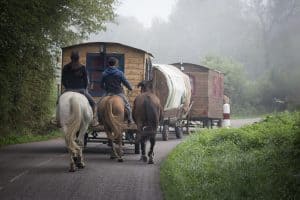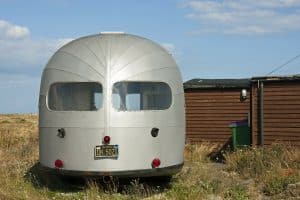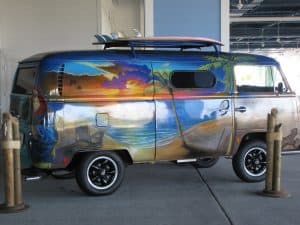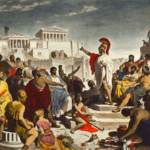Today, recreational vehicles, otherwise known as RVs, are used for just about everything from long distance travel to transporting touring musicians. But in reality, this is nothing new. The production and sale of RVs in the United States is a multi-million-dollar industry with a rich history over the past 100 years.
To some, it might be hard to believe that RVs have been around since cars were first mass-produced. However, to others, that the United States was the place where a vehicle designed to help people explore the unknown was invented shouldn’t come as a surprise; the people who came to live in the “land of the free” were, and continue to be, nomadically-spirited by nature.
Recommended Reading
Boil, Bubble, Toil, and Trouble: The Salem Witch Trials
The History of Christmas
The Great Irish Potato Famine
But the history of RVs is closely tied to the history of the automobile, largely because the growth in the number of cars forced the improvement of dirt roads and this made it easier for people to travel around the country. As a result, we can say it’s the combination of technological advancement and American wanderlust that ultimately created the modern RV industry.
Freedom from the Lodging System
At the beginning of the 20th century, during the early days of the automobile and before the invention of the RV, people traveling long distance would need to sleep inside private rail cars. However, the rail system was limited. It didn’t always have the ability to get people where they wanted to go, and there were strict schedules to follow to get to your final destination. This is part of the reason why the automobile became so popular so quickly, and as it did, Americans began to develop a deep interest in traveling, camping, and exploring the country and its many national parks.
However, back in the 1900s, when cars were still rising to popularity, there were very few gas stations and paved roads, making traveling long distances by car a lot more challenging. Those lucky enough during this time period to own a car had the option of staying at a hotel. But we shouldn’t forget that hotels in the early 1900s operated much differently than they do now. They had strict rules and customs.
For example, checking into a hotel required interactions with bellhops, doorkeepers and baggage men, all of which would be expecting a tip from you before you could even reach the front desk. Then, when you finally made it to the front desk, the clerk would determine if there was a room available and what the costs would be. It was considered bad manners to ask for the price prior to committing your stay. As a result, this kind of travel was reserved for people with considerable means.
So, to avoid the very complicated hotel process and the limitations of the rail system, savvy entrepreneurs started modifying cars with canvas tents. Thus, the RV industry began.
The First RVs

During the 1800s, gypsies would use covered wagons throughout Europe. This innovative technique allowed them to live out of their wagons while being constantly on the move. It is believed these covered gypsy wagons are what sparked the creation of some of the very first RV campers in the United States.
The first RVs in America were independently built as single units. According to Smithsonian, the first RV was hand built onto a vehicle in 1904. It was illuminated through incandescent lights, and it featured an icebox and a radio. It could sleep up to four adults on bunks. Pop-Up Campers soon followed.
It wasn’t until 1910 that the first motorized campers started being produced in large quantities and became available for commercial sale. These first RVs provided very minimal temporary comfort. However, they allowed for a good night’s rest and a home-cooked meal.
The 1910s

As automobiles were becoming more inexpensive, and with incomes on the rise, car sales were skyrocketing and so was the population of camping enthusiasts. People began finding innovative ways to customize cars by hand to have lockers, bunks, and water tanks. These custom-built camper cars were usually in the form of trailers and towables that were hitched to a vehicle. Unlike modern cars, which can tow 3.5-tonne RVs with ease, vehicles of the 1910s were limited to towing no more than a few hundred kilograms. This constraint had profound and lasting implications on RV design.
In 1910, the Pierce-Arrow Touring Landau was the first RV to make its debut at the Madison Square Garden auto show. It was comparable to a modern Class B van camper. This original RV featured a back seat that could fold down into a bed, as well as a sink that could be folded down to create more space.
Furthermore, during this time, the media brought national attention to the new idea of car camping by sharing stories about life on the road. Many of these stories focused on a group known as the Vagabonds, which consisted of Thomas Edison, Henry Ford, Harvey Firestone, and John Burroughs. The infamous group of men would caravan for annual camping trips from 1913 to 1924. For their trips, they brought a custom-outfitted Lincoln truck.
The 1920s
One of the first RV camping clubs, the Tin Can Tourist, formed during this decade. Together, members traveled fearlessly across unpaved roads, acquiring their name from their ritual of heating tin cans of food on gas stoves for dinner.
During the late 1920s, there was an influx of Americans who were starting to resort to creatively living out of their vehicle. Unfortunately, this was usually based on necessity rather than recreation due to the financial crisis of the Great Depression.
The 1930s
Arthur G. Sherman, a bacteriologist, and the president of a pharmaceutical company, was inspired to create a more refined solution for camping trailers. This came as a result of his entire family getting soaked during a thunderstorm while attempting to set up his newly purchased ‘waterproof cabin.’ It was advertised as something that could be done within minutes, but this was a lie.
Later on, Sherman drafted a new look and feel to camping trailers that featured solid walls, and he hired a local carpenter to custom build his new design. Sherman named this new trailer “Covered Wagon,” and it was displayed at the Detroit Auto Show in January 1930.
This new design featured a masonite body which was six-feet wide by nine-feet long, the same height as the typical family car. Each side included a small window for ventilation with an additional two windows at the front. The trailer also included cupboards, built-in furniture, and storage spaces. His asking price? $400. Although that was a hefty price tag for the time, he still managed to sell 118 units by the end of the show.
By 1936 the Covered Wagon was the largest trailer produced in the American industry. Approximately 6,000 units had been sold for a gross sales figure of around $3 million. This became the beginning of the solid-body RV industry and marked the end of tent style trailers.

The first Airstream was also constructed in 1929. It originally started as a contraption which was built over a Model T, but it later became refined into the rounded, teardrop-shaped trailer, allowing it to focus on improving aerodynamics. By 1932, Airstream trailers were being mass produced and sold commercially for $500-1000.
Latest Society Articles
Who Invented Democracy? The True History Behind Democracy
Medieval Fashion: Tunics, Underclothes, Pointed Shoes, and More!
37 Underground Cities: The Hidden Pillars of Civilization
The 1940s
Rationing during World War II caused the production of RVs for consumers to come to a halt, although that didn’t stop them from being used. Instead, RVs were being used in more innovative ways to aid the war effort. Some RV builders were producing them as mobile hospitals, prisoner transports, and even morgues.
In fact, in 1942, the US military purchased thousands of one type of revolutionary trailers known as the “Palace Expando” to house newly enlisted men and their families.
The 1950s
As the young families of returning soldiers became more interested in new, cheap ways to travel, RVs became popular once again in the 1950s. By this time, the majority of the biggest RV manufacturers today were in business making new and improved models on a regular basis, some of which included plumbing and refrigeration. Among these manufacturers were names we recognize today, such as Ford, Winnebago, and Airstream.
More advanced styles of motorized RVs became available for purchase for luxury buyers. For example, the executive flagship RV was built in 1952. It sat on 10 wheels and measured 65 feet long. The interior of this mobile home was decorated with wall-to-wall carpeting, and it had two separate bathrooms, a 21-inch TV, and a portable pool with a diving board. It retailed for a whopping $75,000.
All of this meant that by the end of the 1950s, the term “motorhome” had entered mainstream vernacular.
The 1960s

Up until this time, most entrepreneurs had been focused on converting cars and building trailers. By the 1960s, though, people started giving new life to vans and buses. Many of these newly converted vehicles served as temporary homes for hippies. Of course, the flower power generation made a statement with their mobile homes by giving them psychedelic décor from floor to ceiling inside and out.
In 1962, the novel Travels with Charley, written by John Steinbeck, ushered in a new love for camping as the story was based on a camper who traveled the country in search of adventure.
During this period, Winnebago took advantage of this increasing popularity by mass producing a wide variety of motorhomes at a cheaper price. This began in 1967.
One of the largest international organizations for RV ownership is the Good Sam Club, and it was founded in 1966. Today, it has over 1.8 million members.
Because of all of this, we can say that the 1960s were responsible for entrenching RVs into American culture, and many of the traditions and customs practiced by RV owners today, such as driving to music festivals and national parks, have their roots in this decade.
RVs in Recent Pop Culture
After the 1960s, RV lifestyles became more well-known by merging into pop culture. For example, at the end of the 1970s, Barbie came out with its first traveling motorhome. Today, the Barbie camping line has evolved into several different models, such as the Barbie Pop-Up Camper, and the Barbie DreamCamper Adventure Camping playset.
Over the past 30 years, RVs have received quite a bit of attention from Hollywood. Whether it’s the space-traveling RV featured in Spaceballs, the RV with the CIA command post in Meet The Parents, or Walter White’s portable meth lab in Breaking Bad, RVs are a big part of today’s culture.
READ MORE: The History of Hollywood
RVing has even sparked a movement on social media with thousands of users uploading content featuring #RVLife on an hourly basis.
The Evolution of RVs Today
As we would expect from studying its history, RV technology continues to advance. Today, RVs have full kitchens, bathrooms, washers, and dryers, and there are more types of RV campers than ever before! With hundreds of styles and layouts to choose from, it can make your head spin trying to pick the best one for your needs. Of course, if you’re not ready for the long-term commitment, you can find hundreds of websites allowing you to rent one.
One of the more recent advancements of RV campers is the invention of the toy hauler. Not only are RV campers able to sleep your entire family, but now they even carry your toys such as ATVs, snowmobiles, and motorcycles at the same time.
What is also interesting to note is that the advancements of RVs have inevitably caused a shift in the public’s interest in using them. As they were once popular as a way for occasional camping, or full-time living, now they are changing to allow destination travel as opposed to a singular event. Retail stores such as Walmart, Cracker Barrel, Cabela’s, and Amazon have all begun to embrace the RV culture by catering amenities to those who are on the road.
Explore More Society Articles
37 Underground Cities: The Hidden Pillars of Civilization
Medieval Knights: Heroes and Warriors
History of the Airplane
Counter-Factual History: Valid Exploration or Inappropriate Time Waster?
History of Mother’s Day: The Origin Story Behind Mother’s Day
Boil, Bubble, Toil, and Trouble: The Salem Witch Trials
When we look at how much the RV industry has evolved over the last hundred years, it’s easy to appreciate what it has become today. But through all the changes RVs have gone through, one thing remains the same: The American desire to escape the pressures of modern life, earn a modest living, and enjoy the freedom of life on the road.
Bibliography
Lemke, Timothy (2007). The New Gypsy Caravan. Lulu.com. ISBN 1430302704
Flink, James J. The Automobile Age. Cambridge, Mass.: MIT Press, 1988
Goddard, Stephen B. Getting There: The Epic Struggle Between Road and Rail in the American Century. New York: Basic Books, 1994.
Terence Young, Zócalo Public Square September 4, 2018, https://www.smithsonianmag.com/innovation/brief-history-rv-180970195/
Madeline Diamond, The most iconic RV from every decade, Aug. 23, 2017, https://www.thisisinsider.com/iconic-rvs-evolution-2017-7
Daniel Strohl, Hemmings Find of the Day – 1952 Airstream Cruiser, Jul 24th, 2014, https://www.hemmings.com/blog/2014/07/24/hemmings-find-of-the-day-1952-airstream-cruiser/










Animals make excellent travel companions and an RV gives you a spacious area to keep them comfortable on the open road. Animals adapt very well to the RVing lifestyle and they’d much rather join you for the trip than be left behind at home.
Do you happen to know when the first toy haulers fifth wheels were commercially available?
Very informative of the general use of RVs. My interest is in deveoping measures to improve fuel economy through aerodynamic improvements for Class C vehicles. I am looking for references and previous works on this subject.